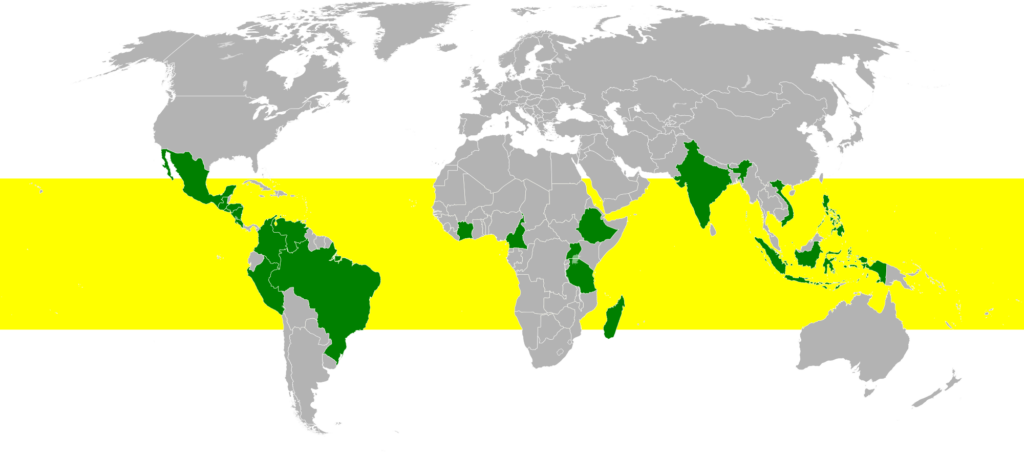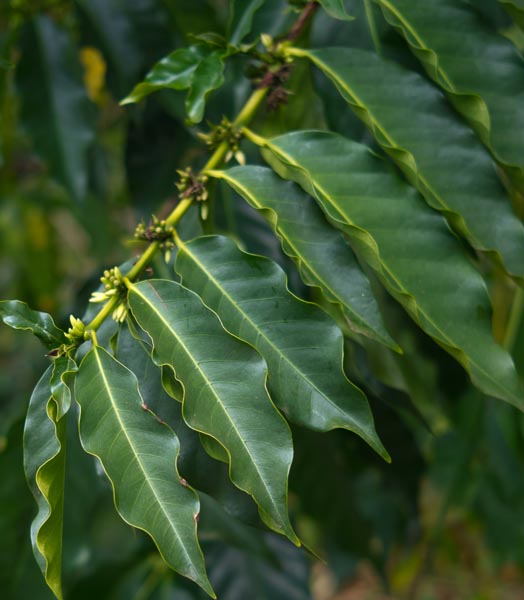Oh coffee, I love you with your magical energy giving abilities! How nice is the thought of growing coffee at your house?
All of the caffeine junkies you know will be hitting you up!
A lot goes in to making a good bean though, I hope you’re ready for the challenge.
Not many of us have the natural habitat for growing coffee right outside of our doors so we have a few different challenges to overcome.
Growing from seed?
I’ll tell you now, you will need lots of patience if you’re going to grow from seed!
To give yourself the best opportunity,start with a freshly picked coffee cherry. I can’t find a place online that sells them but I got my first coffee plant from a local nursery.
Take a look around your area, you never know what you might find.
If anybody knows where you can get fresh picked coffee cherries please send a link this way so we can share it!
But, If feel up to the, very rewarding challenge of growing from seed the easiest place to get started is by ordering from sweet maria’s.
You can also get some green coffee seeds on amazon, however the seeds you get from amazon aren’t always guaranteed fresh.
or if you want the easiest route,
You can always just purchase baby coffees from amazon too.
Arabica or Robusta?
Its good to know that the best tasting beans come from a healthy well cultivated Coffee Arbica plant, which is the species that produces roughly 75% of the worlds coffee.
You may have also heard of Robusta coffee as well, This is the second most popular variety that is commonly traded. But it is a know to be an inferior tasting bean. However there are some specialty robusta growers that are trying to change that.
The robusta plant itself is a much more hearty one. It can thrive in environments arabica plants would shrivel up in.
One could argue that you can grow a better robusta plant at home than you could an arabica plant because there is a larger portion of people who actually posses the natural growing conditions that coffee needs to thrive.
Having a healthy coffee plant is crucial to producing the nectar of the gods.

Origins
Let’s get to know our friend coffee a little bit, it’s origins are actually that of legend, according to the National Coffee Association USA
“No one knows exactly how or when it was discovered, though there are many legends about it’s origin.”
The most common one being that it was first discovered in Ethiopia by a farmer who noticed his goats eating the cherries off of the coffee plants and then these goats were getting all amped up.
Where ever coffee originated from doesn’t make that big of a difference to us as home growers but what we do need to know is that coffee thrives in two optimal climates according to coffee research.org.
These climates are found close to the equator and then an area 10-24 degrees north or south of the equator.
The best conditions for coffee to be grown in is found near the equatorial zone. In a region called the “bean belt.”

Most of these areas are on mountain tops at elevations of between 1800-6300 feet above sea level for arabica plants.
a higher elevation does make a better cup of coffee, that’s for sure. The higher altitude allows the beans a better environment to develop. The air is thinner and this let’s the bean become more dense as it ripens slower, packing itself with great tasting sugars.
Not all of us have the luxury of being on a mountain or in the bean belt but fear not, you can still have a happy plant that produces good beans.
You can grow a healthy thriving Robusta plant at sea level without a problem. Robusta has a lot more forgiveness when it comes to it’s living conditions.
Also, altitude is not the only thing that affects a coffee’s taste, There is a long list of things that will alter the flavor of your coffee. The soil, watering, amount of sun, and the way the beans are processed all affect the final outcome.
But if you have the dedication you can certainly grow a healthy Arabica plant at home too by choosing the perfect spot for it in your house or yard. choosing to plant underneath larger plants, preferably on an east side of the house if you are planting outside or in front of a south facing window for growing indoors. These two locations give the brightest indirect light.
Ideal climate for growing coffee
Coffee is a tropical to sub-tropical evergreen shrub. It likes moderate temperatures.
According to NOAA, Coffee arbica’s ideal temperature range for growing is 64°–70°F.
Arbica coffee can still be grown in conditions where the temperature is above or below that mark, that is the ideal temperature.
It’s not until the average temperature reaches 86°F that the Arabica plant’s growth is stunted.
If the temperature is approaching that degree, fruit development will begin to accelerate. At first that may not sound like a bad thing. You’d get your coffee faster right?
However, ripening at a quick pace does not allow the plant to pump the bean full of flavorful sugars that provide a great taste.
But not many of us around the world have constantly beautiful temps year round. For this reason, I recommend having your plants permanent home be mobile!
By planting your coffee tree in a pot you are able to bring the plant inside your home or green house or shade house if conditions get too hot or too cold.
When it comes to coffee Robusta, these plants can really thrive in much warmer climates(64-97°F).
Neither Robusta or Arabic plants likes frost. They actually hate it to death! (literally.)
If you expect frost, be sure to take your plants to a warmer environment, whether that be to a green house or just inside your home.
How much sunlight does a growing coffee plant need?
Naturally growing coffee is an under story type of plant, meaning that it prefers to grow in the shade of larger trees. Coffee prefers bright, but indirect light.

Coffee growing in a perfect environment
I find that my plant looks the best when it receives lots of bright light in the early morning.
As the day goes on I have my plants positioned so that they receive shade from surrounding trees so that the intense mid day sun can not beat down on them.
This creates a micro climate that also raises relative humidity and drops the temperature in a small area around the plant.
If you are at the mercy of a wide open field with no trees you can still provide your plants the shade they need by easily building a shade structure out of pvc pipe and shade cloth.
An important note about growing coffee indoors: You will need to provide the humidity that is ideal for coffee, this is simply done by placing your plant on top of a tray full of rocks and water. This will raise the relative humidity in the surrounding area of your coffee tree.
Soil and watering:
When Learning how to grow coffee this topic is an important one and the rules to soil generally apply to both arbica and robusta.
Coffee prefers a loamy/volcanic soil with good water retention but also good drainage. The soil needs to be rich in nutrients to supply the plant with all the essentials for life and a great harvest. Ideal soil conditions are crucial. There is so much to talk about when it comes to soil that I have created a separate article here: soil conditions for coffee.
When it comes to watering, coffee prefers that the soil be moist but not soaking wet. It likes to have water available so that it can take a sip whenever it wants but not drown. This is easier to accomplish with the proper soil mixture which I talk about in my article about ideal coffee soil.
TIP: If you’re having a hard time telling when your plant needs to be watered, a good indication are it’s leaves. If the leaves are droopy and hanging your plant most likely needs a little drink!

Fertilizing and pruning:
To make your Coffee plant even happier, I like to fertilizer with a well balanced fertilizer every 1-3 months. When you are dealing with younger coffee plants phosphorus is an important nutrient in It’s development. This nutrient aids with healthy root growth. When young, developing a strong root system really helps the plant grow. More roots means the plant is able to uptake more nutrients and water.
I like using this fertilizer to provide ideal nutrients when my plant is young(0-3 years).
Because coffee plants have the ability to grow so large, you will eventually have to prune your plant.
Well, really that depends on how much space you have to work with and the variety that you choose.
A Fully grown coffee plant, growing wild can be up to 40 feet tall!
That would make harvesting a real pain. On the typical coffee farm trees are trained to be about 6-7 feet tall. Depending on how much space you have you can train coffee plants into little shrubs even of 3-4 feet tall.
When pruning your coffee plant it’s generally best to do it in the early spring months before a new growth spurt.
To get a fuller, bushier plant you want to focus on pruning the new, green growth.
Take a pair of sharp, clean clippers and cut the stem at a 45 degree angle. Make this cut about a quarter of an inch above where the leaves attach to the stem.
This is known as pinching. Using this technique of only taking off the new growth signals to the plant that it should begin producing even more new growth resulting in a fuller more bushy plant.
Take aways
We as home growers most likely don’t have the same conditions that a coffee plantation will have, They are very unique conditions. However, I do think some one with the dedication can certainly grow a good Arabica plant at home.
But I know that most people can easily grow a healthy Robusta plant at home, They are much easier to care for and produce a larger yield.
The big knock on Robusta is it’s flavor, Some say that it tastes a little on the burnt side.
It has a somewhat smokey taste.
But, Just because someone else doesn’t like the robusta bean doesn’t mean that you won’t like it either.
It’s added to lots of Italian blends for its bold body that it adds to your cup.
As home growers we have an advantage.If you grow them yourself the beans will be as fresh as possible.
You can have complete control over how the beans are processed, Roasted and brewed.
All things that have a dramatic affect on the taste of your cup of coffee.
My take from everything? I think you should grow both arabica and robusta.
Something that this article made me really think about is climate change and how it’s going to affect the coffee industry, With warmer weather that means farmers are going to have to start moving higher up on the mountains.
That means less space for growing.
This is a real problem that we will have to face and I don’t know about you but I’m still gonna need my coffee.
I think choosing to grow our own coffee, even if it’s just one or two plants really helps towards the sustainability of the industry and ensures we all get our caffiene fix.
BONUS:
IF you didn’t get enough about growing coffee from this read, here is a really detailed video all about about how to grow coffee! A gentlemen named Luke made it and he actually grows coffee in Michigan! See you don’t have to be in the bean belt to grow coffee!
This guy really knows his stuff, his youtube channel is MIgardener.



